We all have our best trout fishing rig setup. The Carolina rig is my favorite for most circumstances, and I like running live bait with a running sinker straight to the hook.
However, there are over half a dozen rigs I’ll use, and I will always have the necessary gear in my tackle bag in case circumstances demand.
In this article, we’ll look at 9 common trout rigs you should know how to tie, when to use, and where to use them.
Before we get into it, let’s first address the most common question trout anglers usually field.
What is the best rig for trout fishing?
Page Contents
What is the Best Way to Rig for Trout
There’s no one best way to rig for trout. You may have your preferred rig, but the best way to rig for trout is to rig to conditions.
Yes, a Carolina or bobber rig may be your preferred rig. You’ve had success, and you’re confident in tying them.
But there are circumstances where these rigs may not be appropriate, or there’s an alternative that might present a greater chance of success.
There are also times when a particular rig is completely useless. A running sinker to a live bait hook spells trouble in a location with many snags on a river bed.
Such a location might demand a bobber rig only. Anything but a float rig will guarantee you lose plenty of tackle and catch nothing.
There’s also a case for hedging your bets. Many times, a location might not suggest an ideal rig.
In these cases, it’s often a good idea to rig a few rods with different rigs to see which one performs best.
It’s also very common to deploy a set bait while you work an area with a lure.
I like to set bigger live baits hoping for a trophy trout, while I toss a hard body or experiment with soft plastics.
And yes. Several times, I have had both set bait and lure hook fish simultaneously. Fighting fish on two different rods simultaneously is thrilling, sure.
But there’s a good chance you’ll drop one, maybe even both, as your focus is pulled in many directions.
When it comes to rigging for trout, options abound. And the best rig is usually the rig most suited to conditions.
What is the Best Trout Fishing Rig Setup? Here are 9 Critical Trout Rigs
When you consider the commonly used trout rigs and the personalized variations trout anglers have, you’ll discover many ways to rig for trout.
Here are 9 standard rigs all trout anglers should have in their arsenal.
It’s a good idea to carry the tackle required for all these rigs. You never know what conditions will demand.
Trout Rig with Fixed Bobber Setup
There’s something old-school and traditional about fishing a bobber. I also love the excitement of seeing the float take a dive as a trout consumes the bait.
Although a bobber rig is tricky for kids to tie, it’s a great beginner’s rig. It’s easy to cast and is a great teacher, as you can see strike and bite patterns.
When to Use It
A fixed bobber is ideal when fish congregate at a certain depth – often around a particular structure or cover, taking shelter.
Lakes and ponds are the most likely locations you’ll use a bobber rig. Most of the time, you’ll need still water and little to no wind.
A touch of current is OK, as is a little breeze – you’ll just have to recast back into the strike zone periodically.
Like any float rig, a fixed bobber is used when you want to keep your bait off the bottom at a designated depth in the water column.
Tying a Fixed Bobber Rig
Tie the fixed bobber to the mainline. Tie the leader 2 to 5 feet long to the bottom of the bobber. You can have a longer leader if needed, but it can become tricky to cast when longer.
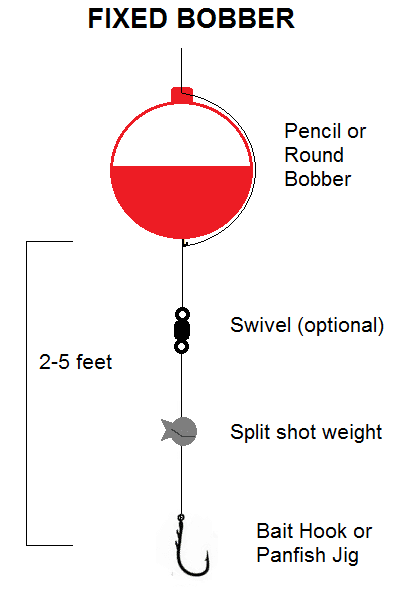
Tie a hook size 8 to 12 to the leader. Now add split shot sinkers to the leader to ensure the bobber sits appropriately in the water.
I like it so that it doesn’t require much pressure from the fish to get it to sink.
Experimentation might be required to get your float sitting properly, depending on the bait you’re using.
Slip Bobber Rig for Trout
A slip Bobber rig is a little more advanced than a fixed bobber but has significant benefits because it can be easily adjusted.
When to Use It
The slip bobber is more versatile than a fixed bobber and can be deployed successfully in many locations and conditions.
A slip bobber would be the default bobber rig for most trout anglers primarily due to its adjustability.
Like any float rig, you use it to keep your bait off the bottom at a specific place in the water column.
I would use it when there’s a little more current about, especially when fishing a stream with plenty of current and water movement.
Tying a Slip Bobber Rig
Thread your bobber stopper onto the mainline, leaving enough line to work with, based on the preferred depth you want your bait.
Now thread your bobber onto the mainline. Fix a swivel or split shot at the minimum depth you want the bait, then connect a size 8 to 12 hook to the end of the line.
Now use a split shot to weigh the float, so it floats appropriately.
Bottom Fishing Rigs for Trout
Slip Sinker Rig for Trout
I like a fish finder rig (slip sinker rig) for bottom fishing for trout. I will usually be using PowerBait or live bait like a minnow.
It’s an easy rig to tie, versatile, and standard for all types of fishing, both saltwater and freshwater.
When to Use a Slip Sinker Rig
I’ll use a slip sinker rig in rivers, lakes, streams, and sometimes ponds. It’s an ideal rig for live baits and an excellent rig for PowerBait.
While I’ll use this rig at any depth, I find I use this rig when I’m fishing deeper. It’s also a great rig for casting, so it’s perfect if I’m land-based.
Essentially, you’re fishing the bottom few feet of the water column, keeping your bait off the bottom to avoid snags, and keeping it in the strike zone.
How to Tie a Slip Sinker Rig
Slip a sinker slider onto the mainline, then connect a swivel to the mainline. Connect the sinker to the slider.
Connect a fluoro or mono leader of 2 to 3 feet to the swivel. Connect a size 8 to 12 light gauge hook to the end of the leader.
Tie the leader to the mainline.
Use as little weight as required as a rule of thumb. This video shows a great slip sinker rig.
Carolina Rig for Trout
The Carolina rig is one of the most common and versatile rigs in fishing. It’s ideal in almost all conditions and locations and is a go-to for most anglers.
By and large, it’s identical to the slip sinker rig. It is indeed a slip sinker rig but fished with a greater variety of baits and even lures.
When to use a Carolina Rig
I’ll use a Carolina rig when I’m actively fishing. I’m holding the rod, moving the bait, adjusting position, and pausing and setting.
With the Carolina rig, the emphasis isn’t so much on keeping the bait off the bottom as it is with the sliding sinker rig.
The sliding sinker rig is also for set baits. As mentioned, a Carolina rig invites more input from the angler.
Use it everywhere, in rivers, ponds, and streams, either land based or afloat. It’s a great casting rig, so ideal from land.
Tying a Carolina Rig
Add a sinker to your mainline then tie on a swivel. Add two to three feet of fluoro or mono leader, with a size 8 to 12 hook.
It doesn’t get much simpler or more versatile and effective than a Carolina rig.

Split Shot Rig for Trout
The split shot rig can take on a few forms. You can use mainline only, use a leader, and fish mono or braid.
There are few rules to split shot rigs, which are often rigged on feel based on the conditions faced.
When to use a Split Shot Rig
I’ll use a split shot rig in heavily fished areas, still and clear conditions, and whenever the bite is tentative.
I’ll use them land-based or afloat whenever there’s little to no current and little to no wind.
Essentially, the split shots are to get the bait down in the water column. If I can avoid the need for sinkers in these conditions, I’ll try to get away with it.
The important aspect for me is the slow sinking of the bait. The bait arrives at the strike zone via a more natural-looking journey – as if connected to nothing.
How to Tie a Split Shot Rig
Tie a size 8 to 12 hook to your mainline. Add split shots to keep your bait where you want it or based on the sink rate.

You can use a swivel and trace if you prefer, which saves you from a little bit of line twist. With some baits, this can be wise.
I like to put the smallest of split shots right above the hook. If this isn’t appropriate, I add them about 2 to three feet from the hook.
I prefer one heavier split shot over multiple, but sometimes you’ll need multiples to adjust to a heavier weight.
Drop Shot Rig for Trout
The drop shot rig is another classic general fishing rig necessary for your trout armory.
It’s great for keeping your bait exactly where you want it in deeper waters, in the lower depths of the water column.
When to Use a Drop Shot Rig for Trout
The drop shot rig is a brilliant casting rig, but it’s a rig I’ll rarely use from land when chasing trout. It’s a brilliant rig fishing from your boat or kayak.
While effective at many depths, I like it for deep lakes and rivers, and I’ll deploy it when I want to keep my bait in a specific depth in the water column, close to the bottom yet off the bottom.
It’s a rig ideal for natural baits of all kinds but also for passively fishing soft plastics with dynamic tails that dance with the slightest movement.
A dropper loop is a variation I’ll use quite frequently, allowing baits to move a little more easily and naturally.
How to tie a Drop Shot Rig for Trout
This can be tied with a leader or straight to the mainline. Tie your hook to the mainline using whichever dropper knot you prefer.

Tie it at the level you want your bait above the bottom, then tie your dropper to the bottom of the main line.
The alternative is to use a 3-way swivel and tie a dropper loop, which I would do most of the time and recommend.
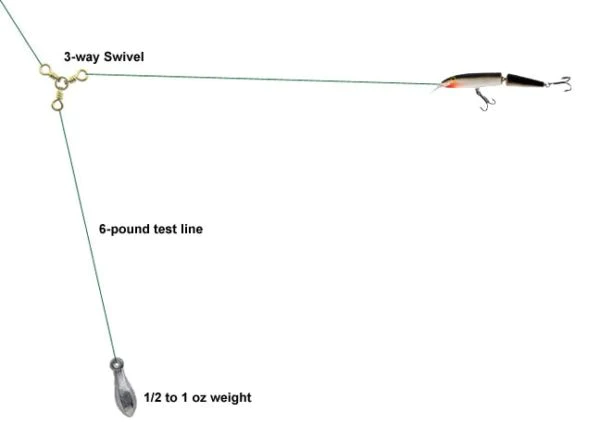
Best Lure Rigs for Trout
Lure fishing for trout is some of the most rewarding. It’s very active and delivers explosive action when you hook up.
I love casting hard bodies. Just connecting a lure to the mainline and casting.
Nothing simpler, nothing better.
Spinner Rig for Trout
There are so many spinner styles on the market you could fish a lifetime and never use them all.
Spinners are probably the most commonly used lure for trout fishing in the US and are great when you have the right one.
When to Use a Spinner Rig for Trout
You can use a spinner rig everywhere from babbling streams to deep lakes and rivers.
I recommend you spin up a storm every time you hit the water. Often, it’s the first thing I do when I arrive at a location.
Just cast a few spinners to see if you get any takers.
I’ve caught so many fish at unlikely times, just throwing a few speculators when arriving at a spot.
If you’re using set baits, don’t sit around waiting; cast spinners while waiting for trout to take your set baits.
Cast at likely fish-holding spots around structure. Don’t be scared to get right in amongst the cover.
This is where you’ll get the best results.
How to tie a Spinner Rig for Trout
My preferred method is always to tie a lure, spinner, soft plastic, or hard body, directly to the mainline using a snap swivel.
This provides the best chance for your lure to maintain peak action throughout the retrieve.
Adding a swivel and leader is a good idea at times, depending on the lure, as it works to mitigate line twist.
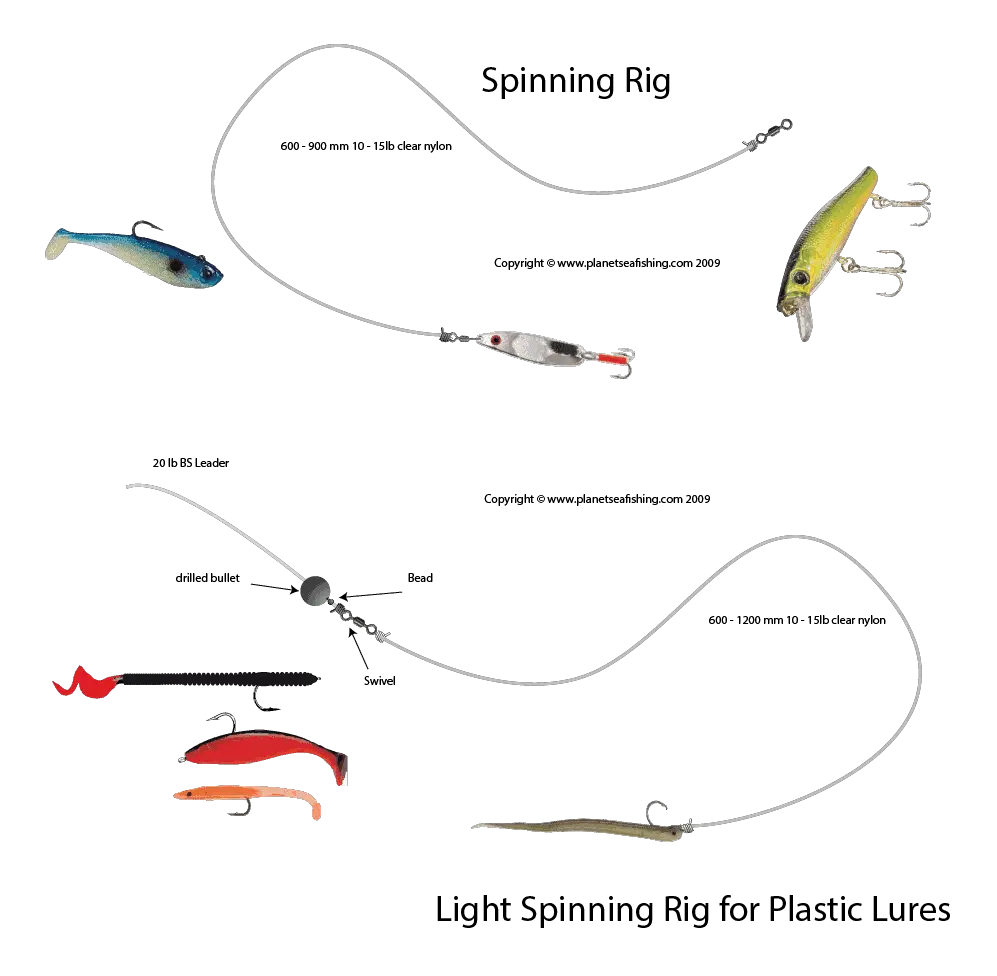
The other option is to add split shots for weight or tie a basic Carolina rig substituting the hook for a lure.
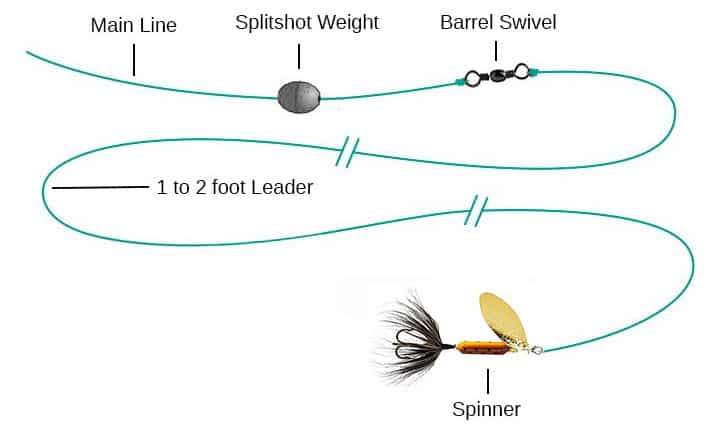
Trout Rig with Bobber and Jig
This is used more commonly than you might think, although it’s reasonably limited to specific locations and conditions.
It can be a very effective way of fishing above the snags in a fast-moving stream. It’s a hectic type of fishing but can deliver great rewards.
When to Use a Bobber and Jig
I like this rig for when the water moves swiftly and you want to keep your lure out of the nightmare snags on the bottom.
It’s great for drifting over weeds and rocky bottoms.
Some experimentation might be required to get your jig exactly where you want it.
Use split shots to get the weighting perfect.
How to tie a Bobber and Jig for Trout
Refer to the slip bobber rig outlined above. Simply substitute the hook for a jig, or whatever lure you feel might encourage an attack.
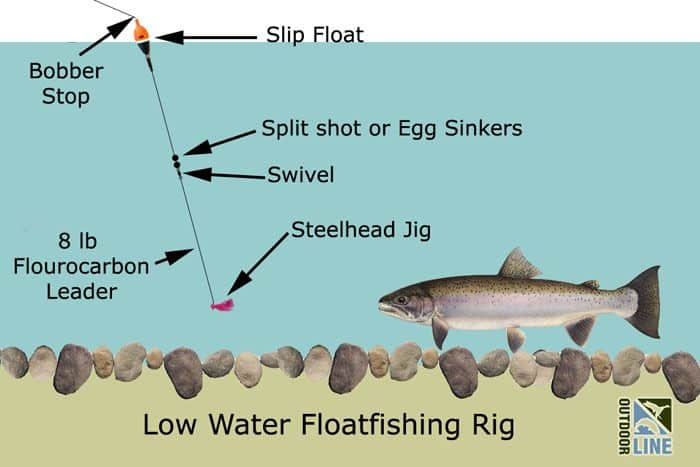
I like to use a larger soft plastic lure, and I’ll often experiment with various profiles.
I’ve had successes with all sorts of profiles that have been sensational one day and hopeless the next.
Experiment – mix it up. Find the profile and color the fish are chasing on the day. Persist.
Ned Rig for Trout
The Ned rig is one of my favorites for trout and is awesome for finesse fishing on light and ultra-light gear.
It’s a go-to for sport-orientated anglers and was born out of the explosion of soft plastics a couple of decades ago.
When to use a Ned Rig
You can use a Ned rig in lakes, rivers, streams, and ponds. Your only limitation is heavy wind, as it can become challenging to cast.
Usually, you’re fishing pretty light – it’s a finesse technique, but should you wish to get down deep, only your lure size and lengths prevent you from using pretty heavy jig heads.
By and large, you’re fishing soft plastics to 3 inches and using jig heads just heavy enough to get you to the bottom.
This method can only become troublesome when heavy weeds or grass is on the river bed.
Snags and poor lure action are common in these conditions.
The Ned rig is ideally cast from land or afloat on your favorite vessel, whether a boat, pontoon, or kayak.
How to tie a Ned Rig
Tie a swivel to a mono or braid mainline. Use a mono or fluoro leader to 3 feet. Tie your lure to the end of your leader. It’s that simple.
There are many soft plastic profiles that are traditional Ned rig styles.
I suggest you experiment with various profiles and sizes, but a traditional Ned rig uses a mushroom-style jig head.
You may wish to add a split shot to get it down, but I prefer not to. You can also go all mainline and forget the leader. Line twist might become a problem if you don’t use a swivel.
This is one of the easiest rigs there is. So simple and very effective on light spin gear.
What are the Best Bait Rigs for Trout?
It will come down to personal preference and the types of locations you fish the most.
I like the slip bobber rig, the Carolina rig, and the fish finder (slip sinker rig) for using natural baits.
I also like dropper rigs for natural baits, especially if fishing a little deeper in the water column.
These rigs will work nicely with everything from worms, maggots, live minnows, PowerBait, strip baits, corn, and salmon eggs.
What Weather is Best for Trout Fishing?
Trout are available all year round and in all types of weather. However, there is a time when conditions are perfect for trout.
It’s a warm spring day. It’s comfortable outside with a light jacket for the very light winds. It’s overcast, some light rain is about, and it’s constantly falling.
The water temperature is about 46 degrees, and it’s getting on to about half past 3 in the afternoon.
In times like this, I’ll sell my soul to be out on the water or a bank by the stream casting at trout.
These are what you’d call perfect conditions. Perfect conditions aren’t a guarantee of fish, but it helps a lot.
How Do You Rig for Trout in a River?
How I rig in a river will depend on the conditions and the river geography. But there are some go-to rigs for most rivers.
Firstly, I love a Carolina rig. It’s versatile, easy to tie, and one of the most successful rigs you can use in a river.
I like a fixed or sliding bobber in a river, and I’ll often use a dropper loop if I’m in a boat and fishing deep.
How Do You Rig for Trout From Shore?
I’ll use nearly every rig listed above fishing from shore. My go-to land-based rigs are the Carolina rig, the sliding sinker rig, and the slip bobber rig.
I’ll also use Ned rigs and spinner rigs from shore. If conditions are very still and it’s a high-traffic area, I’ll sometimes use a split shot rig, especially if a long cast isn’t required.
By and large, the most important aspect of land-based fishing is your ability to get to the strike zone.
This means you need a rig that casts well. This can mean you need length and/or accuracy.
Frequently Asked Questions
What lb test line should I use for trout?
The line class you select is dependent on several things. Personal preference also comes into the equation.
You’ll find the most popular line classes between 4 pounds and 15 pounds. This is also dependent on whether you’re using braid or mono.
If I’m using a dropper loop with a live minnow, I’m generally hunting a larger class of fish. In which case, I’ll be using a 15-pound braid.
If I’m using a Ned rig, it’s a sports finesse affair, and I’m using no more than 6-pound mono – often only 4 pounds.
If you’re looking for a good standard for most rigs, I like using 6 to 8-pound mono. More often than not, I’ll use mono when chasing trout.
Mono is more forgiving on trout, and they have particularly soft mouths for which braid can be a little too aggressive.
What attracts trout the most?
By and large, it will differ with location, conditions, weather, season, and even time of day.
If I had to give a definitive answer, I’d say the thing that attracts trout the most is an angler’s time on the water thinking critically and creatively about their techniques.
In short, an angler’s dedication to time on the water using proven methods and creative approaches will attract more fish.
Do trout like shallow or deep water?
Trout like both deep and shallow water. They’re cold-blooded and have a preferred temperature zone for comfort.
They’ll move from deep to shallow to find the most comfortable temperatures. But they’ll also move between depths to look for food.
On a standard summer day, I’ll fish at dawn and dusk in the shallows. I’ll also fish in the evening in the shallows.
If I’m fishing through the day when the sun is directly above and at its hottest, I’ll chase fish in deeper waters, where they’re cooler and where their eyes are better shielded from the bright sun.
Sharing is caring!
